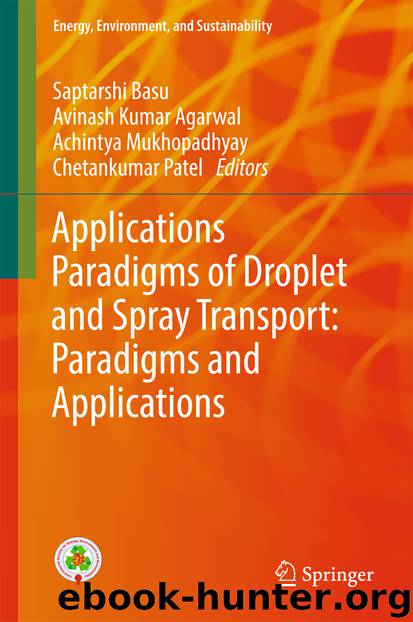Applications Paradigms of Droplet and Spray Transport: Paradigms and Applications by Saptarshi Basu Avinash Kumar Agarwal Achintya Mukhopadhyay & Chetan Patel

Author:Saptarshi Basu, Avinash Kumar Agarwal, Achintya Mukhopadhyay & Chetan Patel
Language: eng
Format: epub
Publisher: Springer Singapore, Singapore
The defining feature for drops of unequal volumes is the higher initial internal pressure difference, compared to drops of equal volumes. Thus, velocities generated soon after interfacial contact are higher in magnitude. The initial velocities created in both sessile and pendant arrangements are comparable, showing that viscosity, as well as gravity, plays only a secondary role in this regime. For pendant drops, pressure difference is partially compensated by gravity, and the velocities attained subsequently are smaller. During the relaxation phase, velocities and shear rates continue to be higher for the sessile, as compared to the pendant case. Combined with a greater centroid movement in the vertical direction, the shear rates for the pendant arrangement are expected to be smaller than for sessile drops. These trends are seen in dimensional (Fig. 5) and dimensionless (Fig. 6) form and are tabulated in Fig. 5f and 6f, respectively. These trends in dimensionless form generalize the physical explanation of coalescence presented in the previous sections.
For unequal volume drops, the time period of oscillations in the x-displacement (and velocity) is visibly greater than those in y. Referring to values of τ 1 in Table 3, the x-movement shows a range of 4–27 over the range of volumes studied, while it is restricted to 6–11 in the y-direction. This result arises from the former being pressure driven and dependent on drop volume, while the latter is affected by gravity.
The Reynolds number arising in coalescence experiments on sessile drops with unequal volume drops is 216. As in experiments with equal volume drops, the total timescale of drop movement including relaxation is mapped to nearly unity.
Download
This site does not store any files on its server. We only index and link to content provided by other sites. Please contact the content providers to delete copyright contents if any and email us, we'll remove relevant links or contents immediately.
| Fluid Dynamics | Thermodynamics |
The Complete Stick Figure Physics Tutorials by Allen Sarah(7307)
Secrets of Antigravity Propulsion: Tesla, UFOs, and Classified Aerospace Technology by Ph.D. Paul A. Laviolette(5309)
Thing Explainer by Randall Munroe(3875)
The River of Consciousness by Oliver Sacks(3535)
The Order of Time by Carlo Rovelli(3144)
How To by Randall Munroe(3031)
A Brief History of Time by Stephen Hawking(2959)
I Live in the Future & Here's How It Works by Nick Bilton(2934)
The Great Unknown by Marcus du Sautoy(2645)
What If?: Serious Scientific Answers to Absurd Hypothetical Questions by Randall Munroe(2637)
Midnight in Chernobyl by Adam Higginbotham(2483)
Blockchain: Ultimate Step By Step Guide To Understanding Blockchain Technology, Bitcoin Creation, and the future of Money (Novice to Expert) by Keizer Söze(2444)
Networks: An Introduction by Newman Mark(2358)
The Meaning of it All by Richard Feynman(2298)
Easy Electronics by Charles Platt(2281)
The Tao of Physics by Fritjof Capra(2227)
Midnight in Chernobyl: The Untold Story of the World's Greatest Nuclear Disaster by Adam Higginbotham(2176)
When by Daniel H Pink(2082)
Introducing Relativity by Bruce Bassett(2076)
